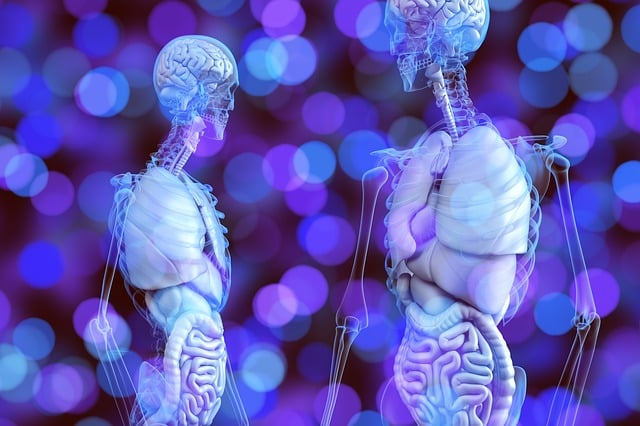The Endocannabinoid System (ECS) is a complex network vital for maintaining bodily homeostasis, regulating processes like pain, appetite, mood, memory, and immunity. This system includes endocannabinoids, CB1 and CB2 receptors, and enzymes. Understanding the ECS is crucial as it explains how cannabis interacts with the body through its cannabinoids, offering potential therapeutic benefits. Imbalances in the ECS contribute to various conditions, making research into its interactions key for developing targeted treatments promoting overall well-being.
Unraveling the mysteries of the endocannabinoid system (ECS) is key to understanding our body’s intricate regulatory network. This complex system, with its key components—endocannabinoids, receptors, and enzymes—plays a vital role in maintaining homeostasis. By exploring the ECS, we gain insights into how it modulates various physiological functions, from pain perception to mood regulation. This article delves into the fundamental aspects of this remarkable receptor network and its implications for overall health.
What is the Endocannabinoid System?

The Endocannabinoid System (ECS) is a complex biological system that plays a pivotal role in maintaining homeostasis, or balance, within our bodies. It’s a network of receptors and molecules, primarily located in the brain and nervous system, but also present in various organs and immune cells. This system was discovered relatively recently, in the late 1980s, and its understanding has revolutionized fields like neuroscience and medicine.
The ECS is involved in a wide range of physiological functions, including pain sensation, appetite, memory, mood, and inflammation response. It operates by releasing and binding specific chemical messengers known as endocannabinoids, which interact with the receptors to modulate their activity. This delicate balance ensures that various body processes function optimally, providing a foundation for overall health and well-being. Understanding the ECS is crucial in comprehending how our bodies regulate themselves and why certain conditions arise when this system becomes imbalanced.
Key Components of the Receptor Network

The receptor network, a vital component of the intricate endocannabinoid system (ECS), plays a pivotal role in maintaining homeostasis within the human body. This complex communication system comprises CB1 and CB2 receptors, which are broadly distributed throughout various organs and tissues. CB1 receptors, predominantly found in the central nervous system, modulate cognitive functions, appetite, and motor control. In contrast, CB2 receptors dominate the peripheral immune cells, influencing inflammation and immune responses.
Understanding the interactions between these receptors and endogenous cannabinoids, such as anandamide and 2-AG, is crucial for comprehending the ECS’s regulatory mechanisms. This network facilitates a delicate balance, acting as a modulator of pain perception, mood, memory, and immune function. By interacting with these receptors, endocannabinoids transmit signals that help regulate physiological processes, ensuring optimal health and homeostasis.
Types of Cannabinoid Receptors

The endocannabinoid system (ECS) is a complex network that plays a crucial role in maintaining homeostasis, or balance, within the human body. Central to this system are cannabinoid receptors, which act as molecular switches, regulating various physiological processes. There are two primary types of cannabinoid receptors: CB1 and CB2.
CB1 receptors are predominantly found in the central nervous system, including brain regions involved in memory, cognition, and coordination. They are also present in peripheral tissues, such as the gastrointestinal tract and blood vessels. On the other hand, CB2 receptors are primarily located in the immune system and peripheral organs, suggesting their involvement in inflammatory responses and pain sensation. Understanding these receptor types is essential in grasping how cannabinoids interact with the ECS, potentially offering therapeutic benefits for various medical conditions.
The Role of Endocannabinoids

The endocannabinoid system (ECS) is a complex cellular network that plays a pivotal role in maintaining the body’s homeostasis, or balance. It consists of endocannabinoids, receptors, and enzymes that work together to regulate various physiological processes, including pain sensation, appetite, mood, memory, and immune response. Endocannabinoids, such as anandamide and 2-AG, are lipid-based molecules produced by the body on demand, acting as neurotransmitters that bind to specific receptors located throughout the body.
Understanding the ECS is crucial in comprehending how cannabis interacts with the human body. Cannabinoids found in the cannabis plant, like THC and CBD, mimic endocannabinoids by binding to the same receptors, thus influencing the ECS’s functions. This interaction can lead to a range of effects, from pain relief and reduced anxiety to changes in appetite and cognitive function. By engaging with the ECS, these cannabinoids may offer therapeutic benefits for various medical conditions, highlighting the significance of further research into this fascinating system.
How Receptor Networks Regulate Various Functions

Receptor networks play a pivotal role in regulating various bodily functions by facilitating communication between different cells and molecules. At the heart of this intricate system is the endocannabinoid system (ECS), which is responsible for maintaining homeostasis, or balance, within the body. The ECS comprises three main components: endocannabinoids (endogenously produced lipids), receptors (CB1 and CB2), and enzymes that degrade endocannabinoids.
Endocannabinoids act as neurotransmitters, binding to CB1 and CB2 receptors present in various organs, including the brain, immune cells, and peripheral nerves. This binding triggers a cascade of events that influence mood, memory, appetite, pain perception, inflammation, and other physiological processes. For instance, activation of CB1 receptors can reduce anxiety and improve cognitive function, while CB2 receptors are involved in modulating immune responses and mitigating chronic inflammation. Understanding the complex interplay within receptor networks, particularly the ECS, is crucial for developing therapeutic strategies aimed at treating a range of conditions and enhancing overall well-being.
Imbalances and Potential Health Implications

Imbalances in the endocannabinoid system (ECS) can have significant health implications, as it plays a crucial role in maintaining homeostasis — the body’s internal balance. Disruptions in this intricate network have been linked to various physiological and psychological conditions. For instance, chronic stress or trauma can alter ECS activity, leading to imbalances that contribute to anxiety, depression, and sleep disorders.
Moreover, understanding the ECS is essential when exploring potential treatments for these conditions. Targeting specific receptors within the system offers a promising approach in developing therapeutic interventions. By modulating endocannabinoid levels and signaling pathways, it may be possible to restore balance and alleviate symptoms associated with ECS dysregulation.
